Wave Optics MCQs
NEET Physics For Waves Multiple Choice Questions
Question 1. Which one of the following statements is true?
- Both light and sound waves can travel in a vacuum
- Both light and sound waves in air are transverse
- The sound waves in air are longitudinal while the light waves are transverse
- Both light and sound waves in air are longitudinal
Answer: 3. The sound waves in air are longitudinal while the light waves are transverse
The sound waves in air are longitudinal while the light waves are transverse
Question 2. A wave travelling in the positive x-direction having displacement along 7-direction as 1 m, wavelength \(2 \pi \mathrm{m}\) and frequency of \(\frac{1}{\pi} H z\) is represented by:
- \(y=\sin (x-2 t)\)
- \(y=\sin (2 \pi x-2 \pi t)\)
- \(y=\sin (10 \pi x-20 \pi t)\)
- \(y=\sin (2 \pi \mathrm{x}-2 \pi t)\)
Answer: 1. \(y=\sin (x-2 t)\)
Given
A wave travelling in the positive x-direction having displacement along 7-direction as 1 m, wavelength \(2 \pi \mathrm{m}\)
According to Question, A =\(1 \mathrm{~m} \)
y =A \(\sin (k x-\omega t)\)
= \(\sin \left(\frac{2 \pi}{2 \pi} x-2 \pi \times \frac{1}{\pi} t\right)\)
= \(\sin (x-2 t)\)
Wave Optics MCQs
Question 3. Two waves are represented by the equations \(y_1=a \sin (\omega t+k x+0.57) \mathrm{m}\) and \(y_2=a \cos (\omega t+k x) \mathrm{m}\), where x in metre and t in second. The phase difference between them is:
- 1.25 rad
- 0.57 rad
- 1.57 rad
- 1.0 rad
Answer: 4. 1.0 rad
It is given that, \(y_1=A \sin (\omega t+k x+0.57) \mathrm{m}\) → Equation 1
and \(y_2=A \cos (\omega t+k x) \mathrm{m}\)
⇒ \(y_2=A \sin \left(\frac{\pi}{2}+\omega t+k x\right) \mathrm{m}\) → Equation 2
Thus from these two equations, \(\Delta \phi =\phi_2-\phi_1\)
= \(\frac{\pi}{2}-0.57\)
=1.57-0.57=1 \(\mathrm{rad}\)
Read and Learn More NEET Physics MCQs
Question 4. A wave in a string has an amplitude of 2 cm. The wave travels in the + x direction with a speed of 128 ms-1 and it is noted that 5 complete waves fit in the 4 m length of the string. The equation describing the wave is:
- y= (0.02)m sin(7.85x + 1005t)
- y = (0.02)m sin (15.7x- 2010t)
- y = (0.02)m sin(15.7x + 2010t)
- y = (0.02)m sin (7.85x + 1005t)
Answer: 4. 7 = (0.02)m sin (7.85x + 1005t)
Given
A wave in a string has an amplitude of 2 cm. The wave travels in the + x direction with a speed of 128 ms-1 and it is noted that 5 complete waves fit in the 4 m length of the string.
According to the question, A =2 \(\mathrm{~cm}\) and
Direction =+x direction
v =128 \(\mathrm{~ms}^{-1}\)
k =\(\frac{2 \pi}{\lambda}=\frac{2 \pi \times 5}{4}=7.85\)
And v =\(\frac{\omega}{k}=128 \mathrm{~ms}^{-1}\)
⇒ \(\omega =v \times k=128 \times 7.85=1005\)
y =\(A \sin (k x-\omega t) \)
becomes y =2 \(\sin (7.85 x-1005 t)\)
= (0.02) m \(\sin (7.85 x-1005 t)\)
Wave Optics MCQs
Question 5. The wave described by y = \(y=0.25 \sin (10 \pi x-2 \pi t)\), where x and y are in metres and t in second, is a wave travelling along the:
- – ve x – direction with frequency 1 Hz
- + ve x – direction with frequency π Hz and wavelength λ = 0.2m
- + ve x – direction with frequency 1 Hz and wavelength λ = 0.2 m
- + ve x – direction with amplitude 0.25 m and wavelength λ = 0.2 m
Answer: 3. + ve x – direction with frequency 1 Hz and wavelength A = 0.2 m
Given, y=0.25\( \sin (10 \pi x-2 \pi t)\)
comparing with equation of wave, y =A \(\sin (k x-\omega t)\)
A=0.25, k =10\( \pi, \omega=2 \pi\)
⇒ \(\frac{2 \pi}{\lambda} =10 \pi\),
2\( \pi f =10 \pi \)
f =5 \(\mathrm{~Hz}\)
⇒ \(\lambda =\frac{1}{5}=0.2 \mathrm{~m}\)
When signs of the coefficient of t and x are opposite it means
⇒ \(\frac{d x}{d t}=v>0\)
i.e. wave is propagating in the direction growing x.
Question 6. A wave travelling in the positive x-direction with amplitude A = 0.2 m, velocity V = 360 ms-1 and wavelength λ = 60 m, then the correct expression for the wave is:
- y=0.2 \(\sin \left[2 \pi\left(6 t+\frac{x}{60}\right)\right]\)
- y=0.2 \(\sin \left[\pi\left(6 t+\frac{x}{60}\right)\right]\)
- y=0.2 \(\sin \left[2 \pi\left(6 t-\frac{x}{60}\right)\right]\)
- y=0.2 \(\sin \left[\pi\left(6 t-\frac{x}{60}\right)\right]\)
Answer: 3. y=0.2 \(\sin \left[2 \pi\left(6 t-\frac{x}{60}\right)\right]\)
The general equation of wave travelling in x-direction is given as
y=A \(\sin \left[\frac{2 \pi}{\lambda}(v t-x)\right]\)
Where, A=\(0.2 \mathrm{~m}, v=360 \mathrm{~ms}^{-1}, \lambda=60 \mathrm{~m}\)
The equation becomes, y=\(0.2 \sin \left[\frac{2 \pi}{60}(360 t-x)\right]\)
y=0.2 \(\sin \left[2 \pi\left(6 t-\frac{x}{60}\right)\right]\)
Question 7. If the initial tension on a stretched string is doubled then the ratio of the initial and final speeds of a transverse wave along the string is:
- 1:1
- \(\sqrt{2}: 1\)
- 1: \(\sqrt{2}\)
- 1: 2
Answer: 3. 1: \(\sqrt{2}\)
We know that the velocity of a transverse wave in a stretched string is, \(\mathrm{v}=\sqrt{\frac{T}{\mu}}\) → Equation 1
Given = Tension, T = 27
Now, the speed of the wave in the string will be \(v^{\prime}=\sqrt{\frac{2 T}{\mu}}\) → Equation 2
from eq (1) and (2), we get
∴ \(\frac{v}{v^{\prime}}=\frac{1}{\sqrt{2}}\)
MCQs On Wave Optics For NEET
Question 8. A uniform rope of length L and mass \(m_1\) hangs vertically from a rigid support. A block of mass \(m_2\) is attached to the free end of the rope. A transverse pulse wavelength \(\lambda_1\) is produced at the lower end of the rope. The wavelength of the pulse when it reaches the top of the A rope is \(\lambda_2\). The ratio \(\frac{\lambda_2}{\lambda_1}\) is:
- \(\sqrt{\frac{m_1+m_2}{m_2}}\)
- \(\sqrt{\frac{m_2}{m_1}}\)
- \(\sqrt{\frac{m_1+m_2}{m_1}}\)
- \(\sqrt{\frac{m_1}{m_2}}\)
Answer: 1. \(\sqrt{\frac{m_1+m_2}{m_2}}\)
Given
A uniform rope of length L and mass \(m_1\) hangs vertically from a rigid support. A block of mass \(m_2\) is attached to the free end of the rope. A transverse pulse wavelength \(\lambda_1\) is produced at the lower end of the rope. The wavelength of the pulse when it reaches the top of the A rope is \(\lambda_2\).
From the question: Wavelength of transverse pulse,
Also, we know that, \(\lambda=\frac{v}{n}\) → Equation 1
Also, we know that,
v= \(\sqrt{\frac{T}{\mu}}\) → Equation 2
v= velocity of the wave,
n= frequency of the wave
T= tension in the string
mu= mass per unit length of rope
From eq. (1) and (2), we get,
⇒ \(\lambda =\frac{1}{n} \sqrt{\frac{T}{\mu}}\)
⇒ \(\lambda \propto \sqrt{T}\)
∴ For different cases \(\frac{\lambda_2}{\lambda_1}=\sqrt{\frac{T_2}{T_1}}=\sqrt{\frac{m_1+m_2}{m_2}}\)
Question 9. The equation of a simple harmonic wave is given by:\(y=3 \sin \frac{\pi}{2}(50 t-x)\), where x and y are in metres and t is in seconds. The ratio of maximum particle velocity to the wave velocity is:
- \(2 \pi\)
- \(\frac{3}{2} \pi\)
- 3 \(\pi\)
- \(\frac{2}{3} \pi\)
Answer: 2. \(\frac{3}{2} \pi\)
We know that and \(v_{\max } =a \omega\)
v =\(n \lambda\)
⇒ \(\frac{v_{\max }}{v} =\frac{a \omega}{n \lambda}\)
= \(\frac{(2 \pi n) a}{n \lambda}=\frac{2 \pi a}{\lambda}\)
= \(\frac{2 \pi a}{\frac{2 \pi}{K}}=\frac{\pi}{2} \times 3=\frac{3 \pi}{2}\)
NEET Physics MCQs
Question 10. Sound waves travel at 350 m/s through warm air at 3500 m/s through brass. The wavelength of a 700 Hz acoustic wave as it enters brass from warm air:
- increases by a factor of 20
- increases by a factor of 10
- decreases by a factor of 20
- decreases by a factor of 10
Answer: 2. increases by a factor of 10
Given, Velocity of ware in warm air \(v_1=350 \mathrm{~m} / \mathrm{s}\)
Velocity of ware in brass,\( v_2=3500 \mathrm{~m} / \mathrm{s}\)
We know that,Velocity of sound, v=\(n \lambda\)
⇒ \(\frac{v_1}{v_2}=\frac{n_1 \lambda_1}{n_2 \lambda_2}\)
Since, \(n_1=n_2 \)
\(\lambda_2=\lambda_1 \frac{v_2}{v_1}\)=\(\lambda_1 \times \frac{3500}{350}\)
=\(\lambda_1 \times 10\)
⇒ \(\lambda_2=10 \lambda_1 \)
∴ \(\frac{v_1}{v_2}=\frac{\lambda_1}{\lambda_2}\)
Question 11. A transverse wave is represented by y =\(y=A \sin (\omega t-k x)\). For what value of the wavelength is the wave velocity equal to the maximum particle velocity?
- \(\frac{\pi \mathrm{A}}{2}\)
- \(\pi A\)
- 2 \(\pi A\)
- A
Answer: 3.
Wave velocity v=\(\frac{\omega}{K}=\omega A\)
⇒ \(\frac{\lambda}{2 \pi}\) =A
∴ \(\lambda =2 \pi A\)
Question 12. Two points are located at a distance of 10 m and 15 m from the source of oscillation. The period of oscillation is 0.05 s and the velocity of the wave is 300 m/s. What is the phase difference between the oscillation of two points?
- \(\frac{\pi}{3}\)
- \(\frac{2 \pi}{3}\)
- \(\pi\)
- \(\frac{\pi}{6}\)
Answer: 2. \(\frac{2 \pi}{3}\)
We know that, Phase-difference, \(\phi=\frac{2 \pi}{\lambda} \times\) path difference
Here path diff., \(\Delta x=15-10=5 \mathrm{~m}\)
Now frequency, v=\(\frac{1}{T}=\frac{1}{0.05}=20 \mathrm{~Hz}\)
velocity \(\mathrm{v}=300 \mathrm{~m} / \mathrm{s}\)
wavelength \(\lambda=\frac{\mathrm{v}}{\mathrm{v}}=\frac{300}{20}=15 \mathrm{~m}\)
Phase difference, \(\Delta \phi=\frac{2 \pi}{\lambda} \times x\)
= \(\frac{2 \pi}{15} \times 5=\frac{2 \pi}{3}\)
NEET Physics MCQs
Question 13. A transverse wave propagating along the x-axis is represented by \(y(x, t)=8.0 \sin (0.5 \pi x-4 \pi t-\pi / 4)\) where x is in metres and t is in seconds. The speed of the wave is:
- 8 \(\mathrm{~m} / \mathrm{s}\)
- 4 \(\pi \mathrm{m} / \mathrm{s}\)
- 0.5 \(\pi \mathrm{m} / \mathrm{s}\)
- \(\frac{1}{2} \mathrm{~m} / \mathrm{s}\)
Answer: 1. 8 \(\mathrm{~m} / \mathrm{s}\)
It is given that, \(y(x, t)=8.0 \sin \left(0.5 \pi x-4 \pi t-\frac{\pi}{4}\right)\)
Compare this equation with the standard equation, we have,
y=\(A \sin \left(\frac{2 \pi x}{\lambda}-\frac{2 \pi t}{\mathrm{~T}}+\phi\right)\)
⇒ \(\frac{2 \pi}{\lambda} =0.5 \pi\)
⇒ \(\lambda =\frac{2 \pi}{0.5 \pi}=4 \mathrm{~m}\)
⇒ \(\frac{2 \pi}{T} =4 \pi\)
T =\(\frac{1}{2} \mathrm{~s}\)
∴ \(\mathrm{v}=\frac{\lambda}{T} =\frac{4}{1 / 2}=8 \mathrm{~m} / \mathrm{s}\)
Question 14. A point source emits sound equally in all directions in a non-absorbing medium. Two points P and Q are at distances of 2 m and 3 m respectively from the source. The ratio of the intensities of the wave at P and Q is:
- 3:2
- 2:3
- 9:4
- 4:9
Answer: 3. 9:4
Given: \(d_1=2 \mathrm{~m}_1, d_2=3 \mathrm{~m}\)
Intensity \(\propto \frac{1}{(\text { distance })^2}\)
⇒ \(I_1 \propto \frac{I}{2^2}\)
And, \(I_2 \propto \frac{1}{3^2}\)
∴ \(\frac{I_1}{I_2}=\frac{9}{4}\)=9: 4
Question 15. The equation of a wave is given by y = a sin\(\left(100 t-\frac{x}{10}\right)\) where x and y are in metres and t in seconds, then the velocity of the wave is:
- 0.1 m/s
- 10 m/s
- 100m/s
- 1000 m/s
Answer: 4. 1000 m/s
We have, y=A \(\sin \left(100 t-\frac{x}{10}\right)\)
On comparing with the standard wave equation, we get \(\omega=100, k=\frac{1}{10}\)
Velocity of the wave, \(\mathrm{v} =\frac{\omega}{k}=\frac{100}{1 / 10}\)
= \(100 \times 10=1000 \mathrm{~m} / \mathrm{s}\)
Class 12 Wave Optics MCQs
Question 16. If Cs be the velocity of sound in air and C be the RMS velocity, then
- \(I_1+I_2\)
- \(\left(\sqrt{I_1}+\sqrt{I_2}\right)^2\)
- \(\left(\sqrt{I_1}-\sqrt{I_2}\right)^2\)
- \(2\left(I_1+I_2\right)\)
Answer: 3. \(\left(\sqrt{I_1}-\sqrt{I_2}\right)^2\)
We have, velocity, \(C_s=\sqrt{\left(\frac{\gamma p}{\rho}\right)}\) → Equation 1
where, p is pressure, \(\rho\) is density and \gamma[/latex] is atomicity of gas,
And RMS velocity of gas molecule, C=\(\sqrt{\left(\frac{3 p}{\rho}\right)}\) → Equation 2
From eq. (1) and (2), we get,
⇒ \(\frac{C_s}{C} =\sqrt{\frac{\gamma p}{\rho} \times \frac{\rho}{3 p}}=\sqrt{\frac{\gamma}{3}}\)
∴ \(C_s =C \times \sqrt{\frac{\gamma}{3}}\)
Question 17. Two periodic waves of intensities \(I_1\) and \(I_2\) pass through a region at the same time in the same direction. The sum of the maximum and minimum intensities is:
- \(I_1+I_2\)
- \(\left(\sqrt{I_1}+\sqrt{I_2}\right)^2\)
- \(\left(\sqrt{I_1}-\sqrt{I_2}\right)^2\)
- \(2\left(I_1+I_2\right)\)
Answer: 4. \(2\left(I_1+I_2\right)\)
I =\(I_1+I_2+2 \sqrt{I_1 I_2} \cos \phi \)
⇒ \(I_{\max } =\left(\sqrt{I_1}+\sqrt{I_2}\right)^2 \)
⇒ \(I_{\min } =\left(\sqrt{I_1}-\sqrt{I_2}\right)^2 \)
⇒ \(I_{\max }+I_{\min } =\left(\sqrt{I_1}+\sqrt{I_2}\right)^2+\left(\sqrt{I_1}-\sqrt{I_2}\right)^2 \)
= \(\left(I_1+I_2+2 \sqrt{I_1 I_2}\right)+\left(I_1+I_2-2 \sqrt{I_1 I}\right)\)
= \(2\left(I_2+I_2\right)\)
Question 18. Two waves of the same frequency and intensity superimpose on each other in opposite phases. After the superposition, the intensity and frequency of waves will:
- increase
- decrease
- remain constant
- become zero
Answer: 4. become zero
Sound and light are both altered by interference. In sound when the resultant intensity is maximum (in phase), the interference is said to be constructive and when the resultant intensity is minimum or zero, it is said to be destructive (in opposite phase).
Class 12 Wave Optics MCQs
Question 19. The length of the string of a musical instrument is 90 cm and has a fundamental frequency of 120 Hz. Where should it be pressed to produce a fundamental frequency of 180 Hz?
- 75 cm
- 60 cm
- 45 cm
- 80 cm
Answer: 2. 60 cm
Length of string of musical instrument = 90cm = 0.9m
fundamental frequency, \(f_1=120 \mathrm{~Hz}, f_2=180 \mathrm{~Hz}\) .
We know that: \(f \propto \frac{1}{l}\)
⇒ \(\frac{f_1}{f_2}=\frac{l_2}{l_1}\)
⇒ \(l_2=\frac{f_1}{f_2} \times l_1\)
⇒ \(l_2=\frac{120}{180} \times 0.9\)
⇒ \(l_2=\frac{2}{3} \times 0.9=0.6 \mathrm{~m}\)
∴ \(l_2=60 \mathrm{~cm} \text {. }\)
Question 20. A tuning fork with a frequency of 800 Hz produces resonance in a resonance column tube with the upper end open and the lower end closed by the water surface. Successive resonances are observed at lengths 9.75 cm, 31.25 cm and 52.75 cm. The speed of sound in air is:
- 500 m/s
- 156 m/s
- 344 m/s
- 172 m/s
Answer: 3. 344 m/s
The first and second resonance of the tuning fork of the resonance tube is shown below,
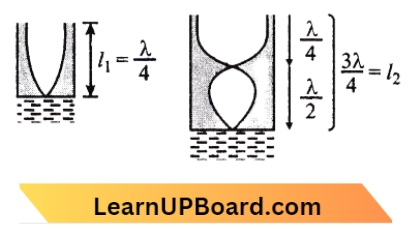
Here,\(l_1=\frac{\lambda}{4} and l_2=\frac{3 \lambda}{4}\)
⇒ \(l_2-l_1 =\frac{3 \lambda}{4}-\frac{\lambda}{4}=\frac{2 \lambda}{4}=\frac{\lambda}{2}\)
⇒ \(\lambda =2\left(l_2-l_1\right)\)
We know that,\( \mathrm{v} =f \lambda\)
⇒ \(\mathrm{v} =800 \times 2(31.25-9.75)\)
= 34400 \(\mathrm{~cm} / \mathrm{s}\)
∴ \(\mathrm{v} =344 \mathrm{~m} / \mathrm{s}\)
Class 12 Wave Optics MCQs
Question 21. The fundamental frequency in an open organ pipe is equal to the third harmonic of a closed organ pipe. If the length of the closed organ pipe is 20 cm, the length of the open organ pipe is:
- 12.5 cm
- 8 cm
- 13.3 cm
- 16 cm
Answer: 3. 13.3 cm
For closed organ pipe.
Third harmonics,\(f=\frac{3 V}{4 l}\) → Equation 1
Where f is the length of a closed organ pipe. for open organ pipe, fundamental frequency, \(f=\frac{V}{2 l^{\prime}}\) → Equation 2
Where I = length of the open organ pipe.
Equating equation (1) and (2)
⇒ \(\frac{3 \mathrm{~V}}{4 l}=\frac{\mathrm{V}}{2 l^{\prime}}\)
⇒ \(l^{\prime} =\frac{4 l}{3 \times 2}=\frac{2 l}{3}\)
⇒ \(l^{\prime} =\frac{2}{3} \times 20=\frac{40}{3}\) [Since l = 20 given ]
=13.33 \(\mathrm{~cm}\)
Question 22. A tuning fork is used to produce resonance in a glass tube. The length of the air column in this tube can be adjusted by a variable piston. At room temperature of 27°C, two successive resonances are produced at 20 cm and 73 cm of column length. If the frequency of the tuning fork is 320 Hz, the velocity of sound in air at 27°C is:
- 350m/s
- 339 m/s
- 330m/s
- 300 m/s
Answer: 2. 339 m/s
Given
A tuning fork is used to produce resonance in a glass tube. The length of the air column in this tube can be adjusted by a variable piston. At room temperature of 27°C, two successive resonances are produced at 20 cm and 73 cm of column length.
For first resonance, \(l_1=\frac{\lambda}{4}\) and second resonance,\(l_2=\frac{3 \lambda}{4}\)
⇒ \(l_2-l_1 =\frac{3 \lambda}{4}-\frac{\lambda}{4}=\frac{\lambda}{2}\)
⇒ \(\lambda =2\left(l_2-l_1\right)\)
Velocity of sound wave
⇒ \(\mathrm{v}=\mathrm{v}\) (Where v= frequency)
⇒ \(\mathrm{v}=\mathrm{v}(2)\left(l_2-l_1\right)\)
⇒ \(\mathrm{v}\)=2[320(0.73-0.202)]
⇒ \(\mathrm{v}=2 \times 320 \times 0.53=339.2 \mathrm{~ms}^{-1}\)
∴ \(\mathrm{v}=339 \mathrm{~ms}^{-1}\)
Class 12 Wave Optics MCQs
Question 23. An air column, closed at one end and open at the other, resonates with a tuning fork when the smallest length of the column at 50 cm. The next larger length of the column resonating with the same tuning fork is:
- 100cm
- 150 cm
- 200cm
- 66.7 cm
Answer: 2. 150 cm
Given
An air column, closed at one end and open at the other, resonates with a tuning fork when the smallest length of the column at 50 cm.
The situation is shown in the given diagram,
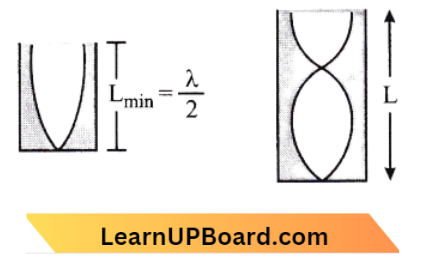
⇒ \(L_{\min } =\frac{\lambda}{4}\)
50 =\(\frac{\lambda}{4}\)
⇒ \(\lambda =200 \mathrm{~cm}\)
Next higher length of an column, L =\(\frac{\lambda}{4}+\frac{\lambda}{2}=\frac{3 \lambda}{4}\)
= \(\frac{3}{4} \times 200=150 \mathrm{~cm}\)
Question 24. The second overtone of an open organ pipe has the same frequency as the first overtone of a closed pipe L metre long. The length of the open pipe will be:
- L
- 2L
- 1/2
- 4L
Answer: 2. 2L
For second overtone (\( 3^{\text {rd }}\) harmonics) in open organ pipe,
⇒ \(\frac{3 \lambda}{2}=l_0\)
⇒ \(\lambda=\frac{2 l_0}{3}\)
for first overtone \(( 3^{\text {rd }}\) harmonics) in closed organ pipe ,
⇒ \(\frac{3 \lambda}{4} =l_c\)
⇒ \(\lambda =\frac{4 l_c}{3}=\frac{4 L}{3}\)
So, \(\frac{2 l_0}{3} =\frac{4 L}{3}\)
∴ \(l_0 =2 L\)
Important MCQs On Wave Optics For NEET
Question 25. The fundamental frequency of a closed organ pipe of length 20 cm is equal to the second overtone of an organ pipe open at both ends. The length of the organ pipe open at both ends is:
- 80 cm
- 100 cm
- 120 cm
- 140 cm
Answer: 3. 120 cm
For closed organ pipe, frequency of vibration \(f_c\) is given,
⇒ \(f_c=\frac{\mathrm{v}}{4 l}\)
l= length of closed organ pipe and for open organ pipe frequency of vibration is \(f_0\).
⇒ \(f_0=\frac{\mathrm{v}}{2 l}\),
l= length of open organ pipe
According to question, \(f_c =3 f_0\)
⇒ \(\frac{V}{4 l}=\frac{3 V}{2 l^{\prime}}\)
⇒ \(l^{\prime}\) =6 l
∴ \(l^{\prime}=6 \times 20=120 \mathrm{~cm}\)
Question 26. A string is stretched between fixed points separated by 75.0 cm. It is observed to have resonant frequencies of 420 Hz and 315 Hz. There are no other resonant frequencies between these two. The lowest resonant frequency for these strings is:
- 155 Hz
- 205 Hz
- 10.5 Hz
- 105 Hz
Answer: 4. 105 Hz
Given
A string is stretched between fixed points separated by 75.0 cm. It is observed to have resonant frequencies of 420 Hz and 315 Hz. There are no other resonant frequencies between these two.
Two consecutive resonant frequencies for a string fixed at both ends will be, \(\frac{n \mathrm{v}}{2 l}\) and \(\frac{(n+1)}{2 l} \mathrm{v}\)
⇒ \(\frac{(n+1) \mathrm{v}}{2 l}-\frac{n \mathrm{v}}{2 l}\) =420-315
∴ \(\frac{\mathrm{v}}{2 l} =105 \mathrm{~Hz}\)
Important MCQs On Wave Optics For NEET
Question 27. If \(n_1, n_2 and n_3\) are the fundamental frequencies of three segments into which a string is divided, then the original fundamental frequency n of the string is given by:
- \(\frac{1}{n}=\frac{1}{n_1}+\frac{1}{n_2}+\frac{1}{n_3}\)
- \(\frac{1}{\sqrt{n}}=\frac{1}{\sqrt{n_1}}+\frac{1}{\sqrt{n_2}}+\frac{1}{\sqrt{n_3}}\)
- \(\sqrt{n}=\sqrt{n_1}+\sqrt{n_2}+\sqrt{n_3}\)
- n=\(n_1+n_2+n_3\)
Answer: 1. \(\frac{1}{n}=\frac{1}{n_1}+\frac{1}{n_2}+\frac{1}{n_3}\)
The string is divided into three points,
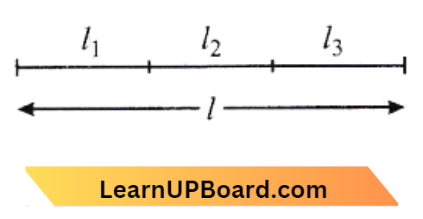
⇒ \(l_1\) has frequency \(n_1\)
⇒ \(l_2\) has frequency \(n_2\)
and \(l_3\) has frequency \(n_3\)
Using \(\mathrm{v} =f \lambda\)
⇒ \(\lambda =\frac{\mathrm{v}}{f}\)
⇒ \(l_1 =\frac{\mathrm{v}}{n_1}, l_2=\frac{\mathrm{v}}{n_2}, l_3=\frac{\mathrm{v}}{n_3}\)
⇒ \(l =l_1+l_2+l_3\)
⇒ \(\frac{\mathrm{v}}{n} =\frac{\mathrm{v}}{n_1}+\frac{\mathrm{v}}{n_2}+\frac{\mathrm{v}}{n_3}\)
where, \(\mathrm{v}\) is same in all case,
∴ \(\frac{1}{n}=\frac{1}{n_1}+\frac{1}{n_2}+\frac{1}{n_3}\)
Important MCQs On Wave Optics For NEET
Question 28. The number of possible natural oscillations of the air column in a pipe closed at one end of length 85 cm whose frequencies lie below 1250 Hz are (velocity of sound = 340 ms-1):
- 4
- 5
- 7
- 6
Answer: 4. 6
For pipe closed at one end, \(f_n=n\left(\frac{v}{4 l}\right)\)

= \(n \times \frac{340}{4 \times 85 \times 10^{-2}}\) =100 n
⇒ \(f_1 =100 \mathrm{~Hz}\)
⇒ \(f_2 =300 \mathrm{~Hz}\)
⇒ \(f_3 =500 \mathrm{~Hz}\)
⇒ \(f_4 =700 \mathrm{~Hz}\)
⇒ \(f_5 =900 \mathrm{~Hz}\)
⇒ \(f_6 =1100 \mathrm{~Hz}\)
∴ This confirms that the number of possible natural oscillations could be 6.
Question 29. If we study the vibration of a pipe open at both ends, then the following statement is not true:
- Open and will be anti-node.
- Odd harmonics of the fundamental frequency will be generated.
- All harmonics of the fundamental frequency will be generated.
- Pressure change will be maximum at both ends.
Answer: 4. Pressure change will be maximum at both ends.
In the study of the vibration of a pipe open at both ends, the displacement node is the pressure antinode. So, the pressure change will be Maximum at the length \(\frac{1}{2}\) and the pressure variation will be minimum at both ends. The odd and even harmonics will be present in the vibration.
Question 30. The time of reverberation of room A is one second. What will be the time (in seconds) of reverberation of a room, having all the dimensions double those of room A?
- 1
- 2
- 4
- \(\frac{1}{2}\)
Answer: 2. 2
Reverberation Time, \(T=\frac{0.61 \mathrm{~V}}{\mathrm{~A} S}\)
Where, Z= Volume of room in cubic metres,4= Average absorption coefficient of the room S= Total surface area of the room in square metres
Clearly, T \(\propto \frac{V}{S}\)
⇒ \(\frac{T_1}{T_2} =\left(\frac{V_1}{V_2}\right)\left(\frac{S_2}{S_1}\right)\)
=\(\left(\frac{V}{8 V}\right)\left(\frac{4 S}{S}\right)=\frac{1}{2} \)
∴ \(T_2 =2 T_1=2 \times 1=2 \mathrm{~s}\) . \(( T_1=1 \mathrm{~s}\)
Important MCQs On Wave Optics For NEET
Question 31. Standing waves are produced in a 10 m-long stretched string. If the string vibrates in 5 segments and the wave velocity is 20 m/s, the frequency is:
- 10 Hz
- 5 Hz
- 4 Hz
- 2 Hz
Answer: 2. 5 Hz
For standing wave, the length of one segment will be \(\frac{\lambda}{2}\)}.
Since there are 5 segments and the total length of the string is 10 \(\mathrm{~m}\).
⇒ \(5 \times \frac{\lambda}{2}\) =10
⇒ \(\lambda =4 \mathrm{~m}\)
∴ Thus, frequency, n=\(\frac{\mathrm{v}}{\lambda}=\frac{20}{4}=5 \mathrm{~Hz}\mathrm{v}=20 \mathrm{~m} / \mathrm{s})\)
Question 32. Which one of the following is a simple harmonic motion?
- Ball bouncing between two rigid vertical walls.
- Particles move in a circle with uniform speed.
- Wave moving through a string fixed at both ends
- Earth spinning about its own axis
Answer: 3. Wave moving through a string fixed at both ends
In Simple harmonic motion, Individual particles of a medium execute simple harmonic motion about their mean position in a direction perpendicular to the direction of propagation of wave motion. SHM is performed by a wave travelling across a string with both ends fixed
Question 33. In a guitar, two strings A and B made of the same material are slightly out of tune and produce beats of a frequency of 6 Hz. When tension in B is slightly decreased, the beat frequency increases to 7 Hz. if the frequency of A is 530 Hz, the original frequency of B will be:
- 524 Hz
- 536 Hz
- 537 Hz
- 523 Hz
Answer: 1. 524 Hz
Given
In a guitar, two strings A and B made of the same material are slightly out of tune and produce beats of a frequency of 6 Hz. When tension in B is slightly decreased, the beat frequency increases to 7 Hz.
In the case of beat formation.
Unknown frequency \(v_B=v_A \pm\) beats
Where \(v_A=530 \mathrm{~Hz} \text {, beats }=6 \mathrm{~Hz}\)
⇒ \(v_B=530 \pm 6=536 \text {, or } 524 \mathrm{~Hz}\)
From the question, when tension is. B is slightly decreased, and then the beat frequency increases to 7 Hz. Thus the original frequency B is 524 Hz.
NEET Wave Optics Questions
Question 34. Three sound waves of equal amplitudes have frequencies (n – 1), n, (n +1). They superimpose to give beats. The number of beats produced per second will be:
- 1
- 4
- 3
- 2
Answer: 4. 2
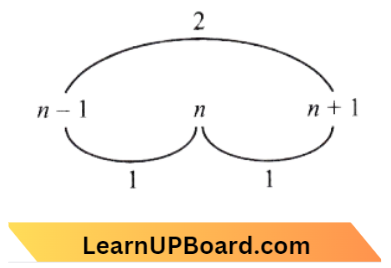
Now divide 1 second into 1,1,2, equal divisions
⇒ \(\frac{1}{1}, \frac{1}{1}, \frac{2}{1}\)
By eliminating common time instants, the total maxima in one second is 2.
Question 35. A source of unknown frequency gives 4 beats/s when sounded with a source of known frequency 250 Hz. The second harmonic of the source of unknown frequency gives five beats per second when sounded with the source of frequency 513 Hz. unknown frequency is:
- 254 Hz
- 246 Hz
- 240 Hz
- 260 Hz
Answer: 1. 254 Hz
Frequency of unknown source =246 Hz or 254 Hz
second harmonic of this source = 492Hz or 508 Hz
when given 5 beats per second when sounded with a source frequency of 513 Hz.
Therefore, unknown frequency = 254 Hz.
Question 36. Two identical piano wires kept under the same tension T have a fundamental frequency of 600 Hz. The fractional increase in the tension of one of the wires which will lead to the occurrence of 6 beat/s when both the wires oscillate together would be:
- 0.02
- 0.03
- 0.04
- 0.01
Answer: 1. 0.02
According To the Question, the Frequency of the string varies directly as the square root of its tension.
f \(\propto \sqrt{T}\)
⇒ \(\frac{\Delta f}{f} =\frac{1}{2} \cdot \frac{\Delta T}{T}\)
⇒ \(\frac{\Delta T}{T} =2 \cdot \frac{\Delta f}{f}\)
=2 \(\times \frac{6}{600}\)=0.02
NEET Wave Optics Questions
Question 37. A tuning fork of frequency 512 Hz makes 4 beats/.? with the vibrating string of beats. The beat frequency decreases to 2 beats when the tension in the piano string is slightly increased. The frequency of the piano string before increasing the tension was:
- 510 Hz
- 514 Hz
- 516 Hz
- 508 Hz
Answer: 4. 508 Hz
Given
A tuning fork of frequency 512 Hz makes 4 beats/.? with the vibrating string of beats. The beat frequency decreases to 2 beats when the tension in the piano string is slightly increased.
We have, \(n_p \propto \sqrt{\mathrm{T}}\)
⇒ \(n_f\)= frequency of tuning fork =\(\frac{5}{2} \mathrm{~Hz} x\)= Beat frequency =4 beats
Hence, \(n_p-n_f=x \downarrow \text { (wrong) }\)
⇒ \(n_f-n_p=x \downarrow \text { (correct) }\)
∴ \(n_p=n_f-x=512-4=508 \mathrm{~Hz}\)
Question 38. Each of the two strings of length 51.6 cm and 49.1 cm are tensioned separately by 20 N force. The mass per unit length of both the strings is the same and equal to 1 gm1. When both the strings vibrate simultaneously the number of beats is:
- 5
- 7
- 8
- 3
Answer: 2. 7
Given
Each of the two strings of length 51.6 cm and 49.1 cm are tensioned separately by 20 N force. The mass per unit length of both the strings is the same and equal to 1 gm1.
According to the question, Frequency of first string, \(f_1=\frac{1}{2 l} \sqrt{\frac{T}{m}}\)
=\(\frac{1}{2 \times 51.6 \times 10^{-2}} \sqrt{\frac{20}{10^{-3}}}\)
=137.03 Hz
Frequency of second string,
⇒ \(f_2 =\frac{1}{2 \times 49.1 \times 10^{-2}} \sqrt{\frac{20}{10^{-3}}}\)
=144.01 Hz
Number of beats, \(f_2-f_1\)
= 144-137 = 7 beats
Physics MCQs For NEET with Answers
Question 39. Two sound waves with wavelengths 5.0 m and 5.5 m respectively, each propagate in a gas with a velocity of 330 m/s. We expect the following number of beats per second:
- 6
- 12
- 0
- 1
Answer: 1. 6
⇒ \(\text { Frequency }=\frac{\text { Velocity }}{\text { Wave length }}\)
⇒ \(v_1=\frac{\mathbf{v}}{\lambda_1}=\frac{330}{5}=66 \mathrm{~Hz}\)
and \(v_2=\frac{\mathrm{v}}{\lambda_2}=\frac{330}{5 \cdot 5}=60 \mathrm{~Hz}\)
Number of beats per second =\(v_1-v_2 \)
= 66 – 60 = 6 .
Question 40. Two vibrating tuning forks produce progressive waves given y1 = 4 sin 500 πt and y2 = 2 sin 5067πt. Number of beats produced per minute is:
- 360
- 180
- 60
- 3
Answer: 4. 3
⇒ \(y_1 =4 \sin 500 \pi t \)
⇒ \(y_2 =2 \sin 506 \pi t\)
⇒ \(\omega_1 =500 \pi, \omega_2=506 \pi\)
⇒ \(v_1 =\frac{\omega_1}{2 \pi}=\frac{500 \pi}{2 \pi}\)=250
⇒ \( v_2 =\frac{\omega_2}{2 \pi}=\frac{506 \pi}{2 \pi}\)=253
v = \(v_2-v_1=253-250\)
= 3beats/s
Question 41. Two strings A and B have lengths IA and IB and carry masses MA and MB at their lower ends, the upper ends being supported by rigid supports, If, nA and nB are the frequencies of their vibrations and nA = 2 nB, then:
- IA = 4IB, regardless of masses
- IB = 4IB, regardless of masses
- MA = 2 MB, IA= 2IB
- MB = 2 MA, IB = 2IA
Answer: 2. IB = 4IB, regardless of masses
We have, the frequency of vibrations of string, n=\(\frac{1}{2 \pi} \sqrt{\frac{g}{I}}\) → Equation 1
Given, \(n_A=2 n_B\)
⇒ \(\frac{1}{2 \pi} \sqrt{\frac{g}{I_A}}=2 \cdot \frac{1}{2 \pi} \sqrt{\frac{g}{I_B}}\)
⇒ \(\frac{1}{I_A}=\frac{4}{I_B}\)
⇒ \(I_B=4 I_A\)
It is clear from eq (1), that the frequency of vibrations of string does not depend on their masses.
Chapter-Wise MCQs For NEET Physics
Question 42. A wave has SHM (simple harmonic motion) whose period is 4s while another wave which also possesses SHM has a period of 3s. If both are combined, then the resultant wave will have a period equal to:
- 4 s
- 5 s
- 12 s
- 3 s
Answer: 3. 12 s
Beats are produced when both waves are combined. Frequency of beats will be \(v_1-v_2=\frac{1}{T_1}-\frac{1}{T_2}=\frac{1}{3}-\frac{1}{4}=\frac{1}{12}\)
Hence, time period = 12 s
Question 43. Two cars moving in opposite directions approach each other with speeds of 22 m/s and 16.5 m/s respectively. The driver of the first car blows a horn having a frequency of 400 Hz. The frequency heard by the driver of the second car is [velocity of sound 340 m/s]:
- 350 Hz
- 361 Hz
- 411 Hz
- 448 Hz
Answer: 4. 448 Hz
If \(f_0\)= original frequency of source
⇒ \(\mathrm{v}_s\)= speed of source
⇒ \(v_0\)= speed of observer
⇒ \(\mathbf{v}\)= speed of sound
Then if both source and observer are moving towards each other the apparent frequency is \(f_{\mathrm{A}}=f_0\left(\frac{\mathrm{v}+\mathrm{v}_0}{\mathrm{v}-\mathrm{v}_s}\right)\)
In the given question, f0=400, frequency of horn \({v}_0\)=16.5, speed as observe in 2 case.
⇒ \(\mathrm{v}_s\)= Speed of car =22 m/s
The frequency heard by the driver in the car \(f_{\mathrm{A}} =f_0\left(\frac{\mathrm{v}+\mathrm{v}_0}{\mathrm{v}-\mathrm{v}_s}\right)\)
= 400\(\left(\frac{340+16.5}{340-22}\right)=\frac{356.5 \times 400}{318}\)
= 448 Hz
Question 44. A siren emitting a sound of frequency 800 Hz moves away from an observer towards a cliff at a speed of 15 ms-1. Then, the frequency of sound that the observer hears in the echo reflected from the cliff is: (Take velocity of ground in air = 330 ms-1)
- 800 Hz
- 838 Hz
- 885 Hz
- 765 Hz
Answer: 2. 838 Hz
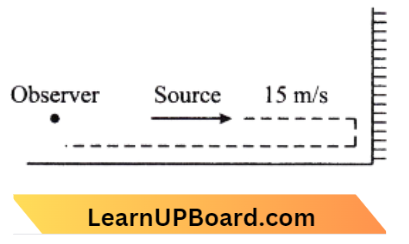
The frequency of sound observed hear in the echo reflected from the diff. is given by
⇒ \(n^{\prime}=\frac{\mathrm{v}}{\mathrm{v}-\mathrm{v}_S} n_0\)
⇒ \({\mathrm{v}=330, \mathrm{v}_s=15, n_o=800 \text { given }}\)
⇒ \(n^{\prime}=\frac{330}{330-15} \times 800 \)
= \(\frac{330 \times 800}{315}=838 \mathrm{~Hz}\)v
Chapter-Wise MCQs for NEET Physics
Question 45. A source of sound S emitting waves of frequency 100 Hz and an observer O are located at some distance from each other. The source is moving with a speed of 19.4 ms-1 at an angle of 60° with the source observer line as shown in the figure. The observer is at rest. The apparent frequency observed by the observer (velocity of sound in air 330 ms-1), is:
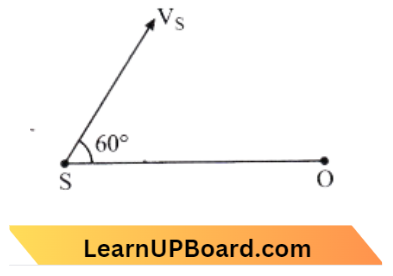
- 100 Hz
- 103 Hz
- 106 Hz
- 97 Hz
Answer: 2. 103 Hz
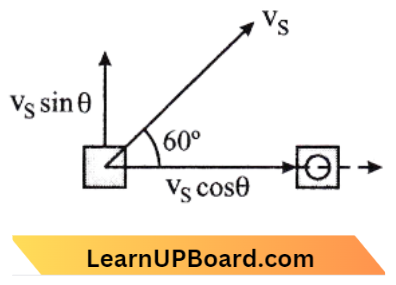
According to question The apparent frequency heard by observer is \(f_0=f_s\left[\frac{\mathrm{v}}{\mathrm{v}-\mathrm{v}_s \cos 60^{\prime \prime}}\right]\)
Given , \(f_s=100 \mathrm{~Hz}\)
⇒ \(\mathrm{v}=330 \mathrm{~m} / \mathrm{s}\)
⇒ \(\mathrm{v}_s=19.4 \mathrm{~ms}^{-1}\)
⇒ \(f_0=100\left[\frac{330}{330-19.4 \times \frac{1}{2}}\right]\)
= \(100\left[\frac{330}{330-9.7}\right]\)
= \(100\left[\frac{330}{320.3}\right]=103.02 \mathrm{~Hz}\)
Interference And Diffraction MCQs
Question 46. A speeding motorcyclist sees a traffic jam ahead of him. He shows down to 36 km/h. He finds that traffic has eased and a car moving ahead of him at 18 km/h is honking at a frequency of 1392 Hz. If the speed of sound is 343 m/s, the frequency of the honk as heard by him will be:
- 1332 Hz
- 1372 Hz
- 1412 Hz
- 1454 Hz
Answer: 3. 1412 Hz
When both observer and source are moving, then the apparent frequency is:
Given: \(\{36 \mathrm{~km} / h=36 \times \frac{5}{18}=10 \mathrm{~ms}^{-1}\).
18 \(\mathrm{~km} / h=18 \times \frac{5}{18}=5 \mathrm{~ms}^{-1}\)
f= \(f_0\left[\frac{\mathrm{v}+\mathrm{v}_0}{\mathrm{v}+\mathrm{v}_{\mathrm{s}}}\right]\left[\text { Since, } f_0=1392 \mathrm{~Hz}\right]\)
= \(1392\left[\frac{343+10}{343+5}\right] \)
= \(1392\left[\frac{353}{348}\right]\)
f= \(1412 \mathrm{~Hz}\)
Question 47. Two sources P and Q produce notes of frequency 660 Hz each. A listener moves from P to Q with a speed of 1 ms-1. If the speed of sound is 330 m/s, then the number of beats heard by the listener per second will be:
- 4
- 8
- 2
- zero
Answer: 1. 4
According to the question,
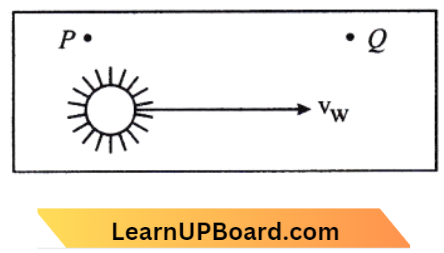
Speed of listener \(\mathrm{v}_L=1 \mathrm{~ms}^{-1}\)
Speed of sound v=330 \mathrm{~ms}^{-1}[/latex]
Frequency of each source v=\(600 \mathrm{~Hz}\)
Apparent frequency due to P=\(\mathrm{v}^{\prime}=\frac{\mathrm{v}\left(\mathrm{v}-\mathrm{v}_{\mathrm{L}}\right)}{\mathrm{v}}\)
Apparent frequency due to \(\mathrm{Q}=\mathrm{v}^{\prime \prime}=\frac{\mathrm{v}\left(\mathrm{v}-\mathrm{v}_{\mathrm{L}}\right)}{\mathrm{v}}\)
No. of beat heard by the listener per second.
⇒ \(\mathrm{V}^{\prime \prime}-\mathrm{V}^{\prime} =\frac{v\left(\mathrm{v}-\mathrm{v}_{\mathrm{L}}\right)}{\mathrm{v}}-\frac{v\left(\mathrm{v}_0-\mathrm{v}_{\mathrm{L}}\right)}{\mathrm{v}}\)
= \(\frac{2 v_{\mathrm{L}}}{v}=\frac{2 \times 660 \times 1}{330}\)=4
Question 48. A train moving at a speed of 200 ms1 toward a stationary object, emits a sound of frequency 100 Hz. Some of the sound reaching the object gets reflected to the train as an echo. The frequency of the echo as detected by the driver of the train is:(speed of sound in air is 300 ms-1)
- 3500 Hz
- 4000 Hz
- 5000 Hz
- 3000 Hz
Answer: 3. 5000 Hz
Given
A train moving at a speed of 200 ms1 toward a stationary object, emits a sound of frequency 100 Hz. Some of the sound reaching the object gets reflected to the train as an echo.
From Doppler’s shift, we have
⇒ \(n^1 =v\left(\frac{v+v_s}{v-v_s}\right)\)
=\(100(\frac{330+220}{330-220})\)
=\(100 \times \frac{550}{110}=5000 \mathrm{~Hz}\)
Interference and Diffraction MCQs
Question 49. The driver of a car travelling with speed 30 ms-1 towards a hill sounds a horn of frequency 600 Hz. If the velocity of sound in air is 330 ms-1, the frequency of reflected sound as heard by the driver is:
- 550 Hz
- 555.5 Hz
- 720 Hz
- 500 Hz
Answer: 3. 720 Hz
Applying Doppler’s effect we have,

⇒ \(n^{\prime \prime} =\frac{v+30}{v-30} n \)
= \(\frac{360}{300} \times 600\)
= \(720 \mathrm{~Hz}\)
Question 50. A car is moving towards a high cliff. The driver sounds a horn of frequency f. The reflected sound heard by the driver has a frequency of 2 f. If v is the velocity of sound, then the velocity of the car, in the same velocity units, will be:
- \(\frac{v}{\sqrt{2}}\)
- \(\frac{v}{3}\)
- \(\frac{v}{4}\)
- \(\frac{v}{2}\)
Answer: 2. \(\frac{v}{3}\)
According to the given conditions,

Cliff is the stationary source of frequency f, where
⇒ \(f^{\prime}=\left(\frac{\mathrm{v}+\mathrm{v}_{\mathrm{car}}}{\mathrm{v}-\mathrm{v}_s}\right) f^{\prime}\)
Frequency heard by the drives or \(f^{\prime \prime}=\left(\frac{\mathrm{v}+\mathrm{v}_{c a r}}{v-v_{\mathrm{s}}}\right) f l\)
2 f=\(\left(\frac{\mathrm{v}+\mathrm{v}_{c a r}}{v-v_{\mathrm{s}}}\right) f\)
⇒ \(v+v_{\text {car }} =2 v-2 v_{\text {car }}\)
⇒ \(3 v_{\text {car }}\) =v
∴ \(v_{\text {car }} =\frac{v}{3}\left(\text { as } v_{\mathrm{s}}=v\right)\)
Question 51. An observer moves towards a stationary source of sound with a speed of 1/5th of the speed of sound. The wavelength and frequency of the source emitted are X and / respectively. The apparent frequency and wavelength recorded by the observer are respectively:
- 1.2f, 1.2λ
- 1.2f, λ
- f, 1.2 λ
- 0.8f, 0.8 λ
Answer: 2. 1.2f, λ
Source is stationary,\(\lambda\)= constants
and f=\(\frac{v+v_{\mathrm{S}}}{v} f=\left(1+\frac{v_{\mathrm{S}}}{v}\right) f\)
= \(\left(1+\frac{1}{5}\right)\) f=1.2 f
Interference And Diffraction MCQs
Question 52. A whistle revolves in a circle with angular speed, co = 20 rad s-1 using a string of length 50 cm. If the frequency of sound from the whistle is 385 Hz, then what is the minimum frequency heard by an observer who is away from the centre (vrorn6: 340 ms 1)?
- 385 Hz
- 374Hz
- 394Hz
- 333 Hz
Answer: 2. 374Hz
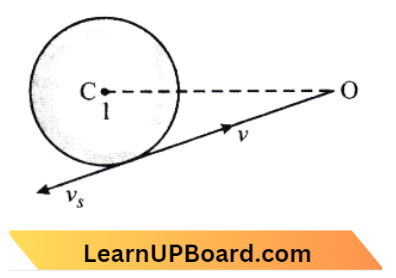
Velocity of source is given as \(v_{\text {source }}=0.5 \times 20=10 \mathrm{~ms}^{-1}\)
Minimum frequency is \(f_{\min } =\left(\frac{\mathrm{v}}{\mathrm{v}+\mathrm{v}_s}\right) f\)
= \(\frac{340}{340+10} \times 385=374 \mathrm{~Hz}\)
Question 53. A vehicle, with a horn of frequency h, is moving with a velocity of 30 m/s in a direction perpendicular to the straight line joining the observer and the vehicle. The observer perceives the sound to have a frequency n+ n1 Then (If the sound velocity in air is 300 m/s):
- n1 = 10n
- n1 = 0
- n1 = 0.1n
- n1 = -0.1n
Answer: 2. n1 = 0
There is no Doppler effect of sound when the velocity of the source (vehicle) is perpendicular to the line between the observer and the source because the component of velocity towards or away from the observer is zero. As a result, there is no apparent difference in frequency. Therefore, n1 = 0.
Wave Optics NEET Questions
Question 54. Two strains move towards each other at the same speed. The speed of sound is 340 m/s. If the height of the tone of the whistle of one of them heard on the other changes 9/8 times, then the speed of each train should be:
- 20 m/s
- 2 m/s
- 200 m/s
- 2000 m/s
Answer: 1.
Given
Two strains move towards each other at the same speed. The speed of sound is 340 m/s. If the height of the tone of the whistle of one of them heard on the other changes 9/8 times,
According to Doppler’s effect, The apparent frequency of sound heard by the listener differs from the actual frequency of sound generated by the source whenever there is relative motion between the source and the listener.
The apparent frequency of sound wave heard by the listener is \(f=\frac{\mathrm{v}-\mathrm{v}_I}{\mathrm{v}-\mathrm{v}_s} \times f\)
where v is the actual frequency of sound emitted by the source, v. is the source’s velocity, and v1 is the listener’s velocity. If v’= (9/8) v and the source and observer are both moving in the same direction at the same speed (say v), the apparent frequency is
⇒ \(f =f \times\left(\frac{v+v_l}{v+v_s}\right)\)
⇒ \(9 f^{\prime} =f \times \frac{340+\mathrm{v}}{340-\mathrm{v}}\)
17 v =\(340 \times 1\)
or v =\(\frac{340}{17}=20 \mathrm{~m} / \mathrm{s}\)
